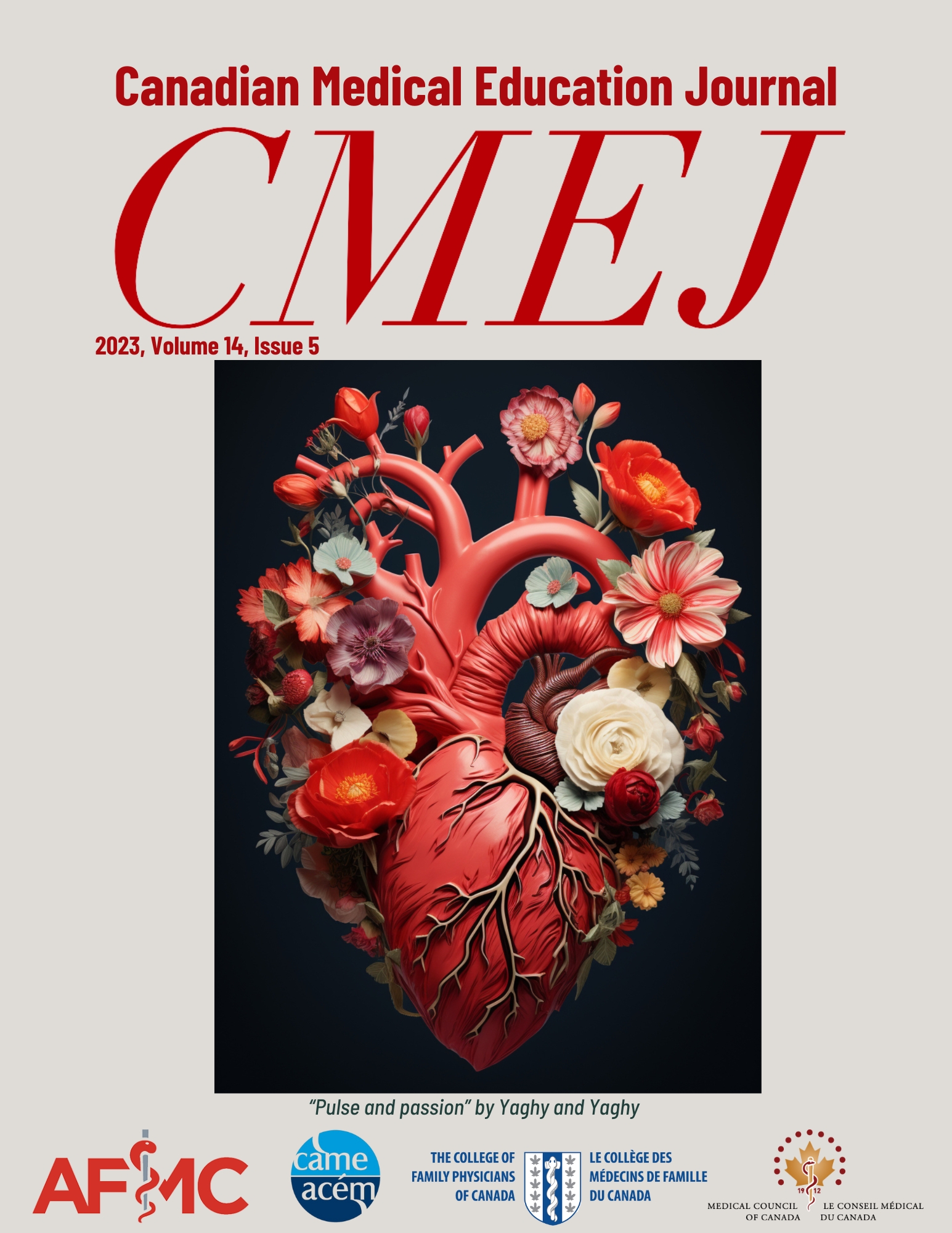Exploring medical students’ use of principles of self-explanation and structured reflection during clerkship
DOI:
https://doi.org/10.36834/cmej.75409Abstract
Background: While educators observe gaps in clerkship students’ clinical reasoning (CR) skills, students report few opportunities to develop them. This study aims at exploring how students who used self-explanation (SE) and structured reflection (SR) for CR learning during preclinical training, applied these learning strategies during clerkship.
Methods: We conducted an explanatory sequential mixed-methods study involving medical students. With a questionnaire, we asked students how frequently they adopted behaviours related to SE and SR during clerkship. Next, we conducted a focus group with students to explore why they adopted these behaviours.
Results: Fifty-two of 198 students answered the questionnaire and five participated in a focus group. Specific behaviours adopted varied from 50% to 98%. We identified three themes about why students used these strategies: as “just in time” learning strategies; to deepen their understanding and identify gaps in knowledge; to develop a practical approach to diagnosis. A fourth theme related to the balance between learning and assessment and its consequence on adopting SE behaviours.
Conclusions: Students having experienced SE and SR regularly in preclinical training tend to transpose these strategies into the clerkship providing them with a practical way to reflect deliberately and capture learning opportunities of the unpredictable clinical context.
References
Williams R, Klamen D, Hoffman R. Medical student acquisition of clinical working knowledge. Teach Learn Med. 2008;20(1):5–10. https://doi.org/10.1080/10401330701542552
Williams RG, Klamen DL, White CB, et al. Tracking development of clinical reasoning ability across five medical schools using a progress test. Acad Med. 2011 Sep;86(9):1148–54. https://doi.org/10.1097/ACM.0b013e31822631b3
Williams RG, Klamen DL. Examining the diagnostic justification abilities of fourth-year medical students. Acad Med. 2012;87(8):1008–14. https://doi.org/10.1097/ACM.0b013e31825cfcff
Williams RG, Klamen DL, Markwell SJ, Cianciolo AT, Colliver JA, Verhulst SJ. Variations in senior medical student diagnostic justification ability. Acad Med. 2014 May;89(5):790. https://doi.org/10.1097/ACM.0000000000000215
Klamen DL. Getting real: embracing the conditions of the third-year clerkship and reimagining the curriculum to enable deliberate practice. Acad Med. 2015;90(10):1314–7. https://doi.org/10.1097/ACM.0000000000000733.
Han H, Roberts NK, Korte R. Learning in the real place : Medical students ’ learning and socialization in clerkships at one medical school. Acad Med. 2015;90(2):231–9. https://doi.org/10.1097/ACM.0000000000000544
Yardley S, Teunissen PW, Dornan T. Experiential learning: transforming theory into practice. Med Teach. 2012;34(2):161–4. https://doi.org/10.3109/0142159X.2012.643264
Chamberland M, St‐Onge C, Setrakian J, et al. The influence of medical students’ self‐explanations on diagnostic performance. Med Educ. 2011 Jul 1;45(7):688–95. https://doi.org/10.1111/j.1365-2923.2011.03933.x
Mamede S, Gog T van, Moura AS, et al. Reflection as a strategy to foster medical students’ acquisition of diagnostic competence. Med Educ. 2012 May 1;46(5):464–72. https://doi.org/10.1111/j.1365-2923.2012.04217.x
Mamede S, van Gog T, Sampaio AM, de Faria RMD, Maria JP, Schmidt HG. How can students’ diagnostic competence benefit most from practice with clinical cases? The effects of structured reflection on future diagnosis of the same and novel diseases. Acad Med. 2014;89(1):121. https://doi.org/10.1097/ACM.0000000000000076
Chi MTH. Self-explaining expository texts: The dual processes of generating inferences and repairing mental models. In: Glaser R, editor. Advances in Instructional Psychology. Mahaw, NJ: Lawrence Erlbaum Associates, Inc; 2000. p. 161–238.
Chamberland M, Mamede S, St‐Onge C, et al. Students’ self-explanations while solving unfamiliar cases: the role of biomedical knowledge. Med Educ. 2013;47(11):1109–16. https://doi.org/10.1111/medu.12253
Renkl A, Eitel A. Self-explaning: Learning about principles and their application. In: Dunlosky J, Rawson KA, editors. The Cambridge handbook of cognition and education. Cambridge: Cambridge Cambridge University Press; 2019. p. 528–49.
Chamberland M, Mamede S, Bergeron L, Varpio L. A layered analysis of self-explanation and structured reflection to support clinical reasoning in medical students. Perspect Med Educ. 2021;10:171–9. https://doi.org/10.1007/s40037-020-00603-2
Chamberland M, Setrakian J, Bergeron L, Varpio L, St-Onge C, Thomas A. Harnessing a knowledge translation framework to implement an undergraduate medical education intervention: a longitudinal study. Perspect Med Educ. 2022;11(6):333-340. https://doi.org/10.1007/s40037-022-00735-7
Creswell JW, Clark VLP. Core mixed methods designs. In: Designing and conducting mixed methods research. Los Angeles: Sage publications; 2017. p. 51-99
Osborne F, Paes P, Ellis J, Rothwell C. Twelve tips for conducting medical education research via videoconference. Med Teach. 2023;45(2):145-151. https://doi.org/10.1080/0142159X.2022.2053087.
DeVellis RF. Guidelines in scale development. Scale development: theory and applications. Los Angeles: Sage publications; 1991.
Braun V, Clarke V. Thematic analysis. In: APA handbook of research methods in psychology, Vol 2: Research designs: Quantitative, qualitative, neuropsychological, and biological. Washington, DC, US: American Psychological Association; 2012. p. 57–71.
Chi MT, Wylie R. The ICAP framework: Linking cognitive engagement to active learning outcomes. Educ Psych. 2014;49(4):219–43. https://doi.org/10.1080/00461520.2014.965823
Chamberland M, Mamede S, St-Onge C, Setrakian J, Schmidt HG. Does medical students’ diagnostic performance improve by observing examples of self-explanation provided by peers or experts? Adv in Health Sci Educ. 2015;20(4):981–93. https://doi.org/10.1007/s10459-014-9576-7
Mamede S, Schmidt HG. The structure of reflective practice in medicine. Med Educ. 2004;38(12):1302–8. https://doi.org/10.1111/j.1365-2929.2004.01917.x
Downloads
Published
Issue
Section
License
Copyright (c) 2023 Martine Chamberland, Vanessa Beaudoin, Isabelle Boulais, Linda Bergeron, Christina St-Onge, Tim Dubé

This work is licensed under a Creative Commons Attribution-NonCommercial-NoDerivatives 4.0 International License.
Submission of an original manuscript to the Canadian Medical Education Journal will be taken to mean that it represents original work not previously published, that it is not being considered elsewhere for publication. If accepted for publication, it will be published online and it will not be published elsewhere in the same form, for commercial purposes, in any language, without the consent of the publisher.
Authors who publish in the Canadian Medical Education Journal agree to release their articles under the Creative Commons Attribution-Noncommercial-No Derivative Works 4.0 Canada Licence. This licence allows anyone to copy and distribute the article for non-commercial purposes provided that appropriate attribution is given. For details of the rights an author grants users of their work, please see the licence summary and the full licence.






